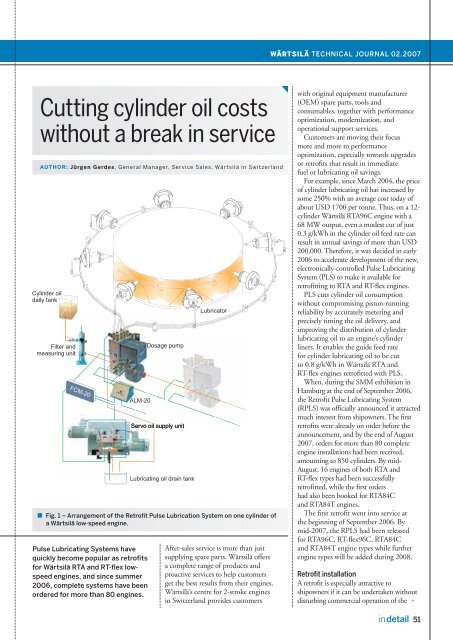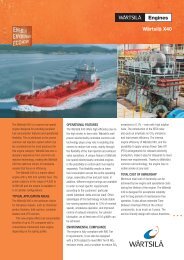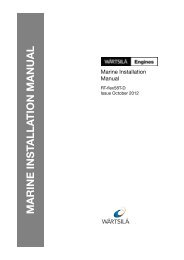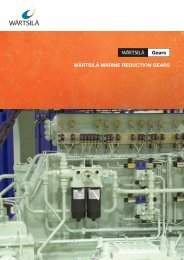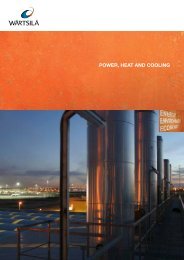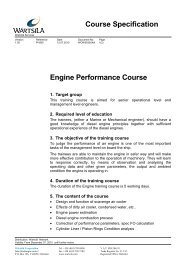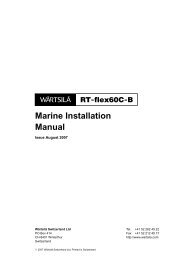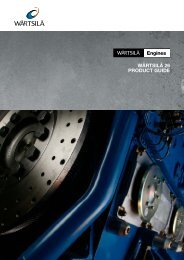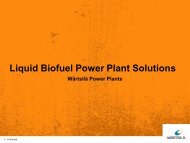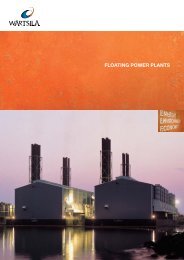Cutting cylinder oil costs without a break in service - Wärtsilä
Cutting cylinder oil costs without a break in service - Wärtsilä
Cutting cylinder oil costs without a break in service - Wärtsilä
Create successful ePaper yourself
Turn your PDF publications into a flip-book with our unique Google optimized e-Paper software.
<strong>Cutt<strong>in</strong>g</strong> <strong>cyl<strong>in</strong>der</strong> <strong>oil</strong> <strong>costs</strong><br />
<strong>without</strong> a <strong>break</strong> <strong>in</strong> <strong>service</strong><br />
AUTHOR: Jürgen Gerdes, General Manager, Service Sales, <strong>Wärtsilä</strong> <strong>in</strong> Switzerland<br />
Cyl<strong>in</strong>der <strong>oil</strong><br />
daily tank<br />
Filter and<br />
measur<strong>in</strong>g unit<br />
FCM-20<br />
ALM-20<br />
Dosage pump<br />
Servo <strong>oil</strong> supply unit<br />
Lubricat<strong>in</strong>g <strong>oil</strong> dra<strong>in</strong> tank<br />
Lubricator<br />
Fig. 1 – Arrangement of the Retrofit Pulse Lubrication System on one <strong>cyl<strong>in</strong>der</strong> of<br />
a <strong>Wärtsilä</strong> low-speed eng<strong>in</strong>e.<br />
Pulse Lubricat<strong>in</strong>g Systems have<br />
quickly become popular as retrofits<br />
for <strong>Wärtsilä</strong> RTA and RT-flex low-<br />
speed eng<strong>in</strong>es, and s<strong>in</strong>ce summer<br />
2006, complete systems have been<br />
ordered for more than 80 eng<strong>in</strong>es.<br />
After-sales <strong>service</strong> is more than just<br />
supply<strong>in</strong>g spare parts. <strong>Wärtsilä</strong> offers<br />
a complete range of products and<br />
proactive <strong>service</strong>s to help customers<br />
get the best results from their eng<strong>in</strong>es.<br />
<strong>Wärtsilä</strong>’s centre for 2-stroke eng<strong>in</strong>es<br />
<strong>in</strong> Switzerland provides customers<br />
WÄRTSILÄ TECHNICAL JOURNAL 02.2007<br />
with orig<strong>in</strong>al equipment manufacturer<br />
(OEM) spare parts, tools and<br />
consumables, together with performance<br />
optimization, modernization, and<br />
operational support <strong>service</strong>s.<br />
Customers are mov<strong>in</strong>g their focus<br />
more and more to performance<br />
optimization, especially towards upgrades<br />
or retrofits that result <strong>in</strong> immediate<br />
fuel or lubricat<strong>in</strong>g <strong>oil</strong> sav<strong>in</strong>gs.<br />
For example, s<strong>in</strong>ce March 2004, the price<br />
of <strong>cyl<strong>in</strong>der</strong> lubricat<strong>in</strong>g <strong>oil</strong> has <strong>in</strong>creased by<br />
some 250% with an average cost today of<br />
about USD 1700 per tonne. Thus, on a 12<strong>cyl<strong>in</strong>der</strong><br />
<strong>Wärtsilä</strong> RTA96C eng<strong>in</strong>e with a<br />
68 MW output, even a modest cut of just<br />
0.3 g/kWh <strong>in</strong> the <strong>cyl<strong>in</strong>der</strong> <strong>oil</strong> feed rate can<br />
result <strong>in</strong> annual sav<strong>in</strong>gs of more than USD<br />
200,000. Therefore, it was decided <strong>in</strong> early<br />
2006 to accelerate development of the new,<br />
electronically-controlled Pulse Lubricat<strong>in</strong>g<br />
System (PLS) to make it available for<br />
retrofitt<strong>in</strong>g to RTA and RT-flex eng<strong>in</strong>es.<br />
PLS cuts <strong>cyl<strong>in</strong>der</strong> <strong>oil</strong> consumption<br />
<strong>without</strong> compromis<strong>in</strong>g piston-runn<strong>in</strong>g<br />
reliability by accurately meter<strong>in</strong>g and<br />
precisely tim<strong>in</strong>g the <strong>oil</strong> delivery, and<br />
improv<strong>in</strong>g the distribution of <strong>cyl<strong>in</strong>der</strong><br />
lubricat<strong>in</strong>g <strong>oil</strong> to an eng<strong>in</strong>e’s <strong>cyl<strong>in</strong>der</strong><br />
l<strong>in</strong>ers. It enables the guide feed rate<br />
for <strong>cyl<strong>in</strong>der</strong> lubricat<strong>in</strong>g <strong>oil</strong> to be cut<br />
to 0.8 g/kWh <strong>in</strong> <strong>Wärtsilä</strong> RTA and<br />
RT-flex eng<strong>in</strong>es retrofitted with PLS.<br />
When, dur<strong>in</strong>g the SMM exhibition <strong>in</strong><br />
Hamburg at the end of September 2006,<br />
the Retrofit Pulse Lubricat<strong>in</strong>g System<br />
(RPLS) was officially announced it attracted<br />
much <strong>in</strong>terest from shipowners. The first<br />
retrofits were already on order before the<br />
announcement, and by the end of August<br />
2007, orders for more than 80 complete<br />
eng<strong>in</strong>e <strong>in</strong>stallations had been received,<br />
amount<strong>in</strong>g to 850 <strong>cyl<strong>in</strong>der</strong>s. By mid-<br />
August, 16 eng<strong>in</strong>es of both RTA and<br />
RT-flex types had been successfully<br />
retrofitted, while the first orders<br />
had also been booked for RTA84C<br />
and RTA84T eng<strong>in</strong>es.<br />
The first retrofit went <strong>in</strong>to <strong>service</strong> at<br />
the beg<strong>in</strong>n<strong>in</strong>g of September 2006. By<br />
mid-2007, the RPLS had been released<br />
for RTA96C, RT-flex96C, RTA84C<br />
and RTA84T eng<strong>in</strong>e types while further<br />
eng<strong>in</strong>e types will be added dur<strong>in</strong>g 2008.<br />
Retrofit <strong>in</strong>stallation<br />
A retrofit is especially attractive to<br />
shipowners if it can be undertaken <strong>without</strong><br />
disturb<strong>in</strong>g commercial operation of the p<br />
<strong>in</strong>detail 51
p [ MARINE / IN DETAIL ]<br />
[ MARINE / IN DETAIL ]<br />
vessel. <strong>Wärtsilä</strong>’s two-stroke center and the<br />
<strong>Wärtsilä</strong> <strong>service</strong>s network are thus work<strong>in</strong>g<br />
<strong>in</strong> close co-operation to m<strong>in</strong>imize the<br />
required <strong>in</strong>stallation time so that RPLS can<br />
be retrofitted <strong>in</strong> a ship while on passage and<br />
dur<strong>in</strong>g a normal port stay. For example,<br />
<strong>Wärtsilä</strong> <strong>in</strong> Korea is manufactur<strong>in</strong>g all<br />
pipework and other mechanical parts.<br />
Before dispatch<strong>in</strong>g the material to the<br />
vessel, it is prefitted on a dummy <strong>in</strong> the<br />
<strong>Wärtsilä</strong> workshop <strong>in</strong> Noksan, South<br />
Korea, to verify that the work is correct.<br />
RPLS is an <strong>in</strong>dependent system with few<br />
connections or <strong>in</strong>terfaces to other systems,<br />
and utilizes the eng<strong>in</strong>e’s exist<strong>in</strong>g <strong>cyl<strong>in</strong>der</strong><br />
l<strong>in</strong>ers. Thus preparation and <strong>in</strong>stallation<br />
are easy and fast. All equipment, <strong>in</strong>clud<strong>in</strong>g<br />
prefabricated pip<strong>in</strong>g, is supplied with<br />
<strong>in</strong>stallation and commission<strong>in</strong>g work be<strong>in</strong>g<br />
undertaken by <strong>Wärtsilä</strong> <strong>service</strong> eng<strong>in</strong>eers.<br />
To a substantial extent this material<br />
can be <strong>in</strong>stalled dur<strong>in</strong>g the voyage,<br />
thereby considerably reduc<strong>in</strong>g the<br />
port time required for fi nish<strong>in</strong>g the<br />
<strong>in</strong>stallation and for the commission<strong>in</strong>g.<br />
Installation of controls, pumps, wir<strong>in</strong>g,<br />
and <strong>in</strong>terface connections to remote and<br />
alarm monitor<strong>in</strong>g systems, is executed<br />
dur<strong>in</strong>g the voyage. Ample attention is<br />
paid to commission<strong>in</strong>g, fi ne adjustment<br />
and the runn<strong>in</strong>g-<strong>in</strong> of the RPLS <strong>in</strong> port<br />
and dur<strong>in</strong>g a confi rmation voyage.<br />
The whole retrofit and commission<strong>in</strong>g<br />
on the first vessel, the 7500 TEU conta<strong>in</strong>er<br />
ship “COSCO SHENZHEN” with a 12<strong>cyl<strong>in</strong>der</strong><br />
<strong>Wärtsilä</strong> RTA96C ma<strong>in</strong> eng<strong>in</strong>e,<br />
could be completed <strong>in</strong> five steps <strong>without</strong><br />
<strong>in</strong>terrupt<strong>in</strong>g the vessel’s schedule:<br />
1. Pre-<strong>in</strong>spection <strong>in</strong> Hong Kong<br />
on 22 June 2006.<br />
2. First <strong>in</strong>stallation trip from Hong<br />
Kong to Yantian dur<strong>in</strong>g 26–27<br />
August. Installation work cont<strong>in</strong>ued<br />
<strong>in</strong> Yantian and dur<strong>in</strong>g the Pacifi c<br />
cross<strong>in</strong>g to Long Beach (USA),<br />
arriv<strong>in</strong>g there on 9 September.<br />
3. The second and fi nal <strong>in</strong>stallation<br />
period <strong>in</strong> Long Beach dur<strong>in</strong>g 9–<br />
11 September, <strong>in</strong>cluded pistonrunn<strong>in</strong>g<br />
related modifi cations.<br />
4. The commission<strong>in</strong>g was carried-out<br />
while on passage from Long Beach to<br />
Oakland, where on 13 September the<br />
f<strong>in</strong>al <strong>in</strong>spection was also carried out.<br />
5. F<strong>in</strong>ally, on her ‘maiden’ passage<br />
to Ch<strong>in</strong>a, measurements and<br />
documentation of the RPLS<br />
performance were carried out.<br />
52 <strong>in</strong>detail<br />
Cyl<strong>in</strong>der <strong>oil</strong> tank<br />
Alarm<br />
monitor<strong>in</strong>g<br />
system<br />
Filter WECS<br />
Ma<strong>in</strong><br />
bear<strong>in</strong>g<br />
<strong>oil</strong><br />
Servo <strong>oil</strong><br />
supply unit<br />
Junction<br />
box<br />
Pressure<br />
sensors<br />
Servo <strong>oil</strong><br />
overfl ow<br />
Fig 2. – Schematic of the RPLS.<br />
Work<strong>in</strong>g pr<strong>in</strong>ciple<br />
The basic pr<strong>in</strong>ciple of the Pulse<br />
Lubricat<strong>in</strong>g System is to deliver metered<br />
quantities of <strong>cyl<strong>in</strong>der</strong> lubricat<strong>in</strong>g <strong>oil</strong><br />
under pressure at precise tim<strong>in</strong>g exactly<br />
<strong>in</strong>to the piston r<strong>in</strong>g package, from<br />
where it is evenly distributed around the<br />
circumference of the <strong>cyl<strong>in</strong>der</strong> l<strong>in</strong>er.<br />
The RPLS is based on a lubricat<strong>in</strong>g<br />
module for each <strong>cyl<strong>in</strong>der</strong> with a dosage<br />
pump and monitor<strong>in</strong>g electronics,<br />
which delivers pressurized <strong>cyl<strong>in</strong>der</strong><br />
lubricat<strong>in</strong>g <strong>oil</strong> to newly developed<br />
lubricators (formerly known as quills)<br />
that fit exist<strong>in</strong>g <strong>cyl<strong>in</strong>der</strong> l<strong>in</strong>ers of the<br />
<strong>Wärtsilä</strong> RTA and RT-flex eng<strong>in</strong>e types.<br />
Each lubricat<strong>in</strong>g module is equipped<br />
with two separate supply l<strong>in</strong>es – for<br />
<strong>cyl<strong>in</strong>der</strong> lubricat<strong>in</strong>g <strong>oil</strong> and servo <strong>oil</strong>.<br />
A separate servo <strong>oil</strong> supply unit is<br />
needed to drive the lubricat<strong>in</strong>g module<br />
for RTA eng<strong>in</strong>es, whereas on RT-fl ex<br />
common rail eng<strong>in</strong>es, the servo <strong>oil</strong> is<br />
taken from the servo <strong>oil</strong> common rail<br />
through a pressure reduc<strong>in</strong>g valve.<br />
Once the <strong>Wärtsilä</strong> Eng<strong>in</strong>e Control<br />
System (WECS) switches the 4/2-way<br />
solenoid valve <strong>in</strong> the lubricat<strong>in</strong>g module<br />
Lubricator<br />
ALM-20<br />
Dosage pump<br />
Cyl<strong>in</strong>der<br />
CAN bus<br />
Power supply<br />
Cyl<strong>in</strong>der <strong>oil</strong><br />
Servo <strong>oil</strong><br />
Servo <strong>oil</strong> return<br />
to the open position, servo <strong>oil</strong> fl ows to<br />
the drive side of the central piston of the<br />
dosage pump <strong>in</strong> the lubricat<strong>in</strong>g module.<br />
As the central piston is actuated, it feeds<br />
<strong>cyl<strong>in</strong>der</strong> lubricat<strong>in</strong>g <strong>oil</strong> from the lubricat<strong>in</strong>g<br />
<strong>oil</strong> supply to the meter<strong>in</strong>g ducts, and then<br />
discharges it from the lubricators at high<br />
pressure. The <strong>cyl<strong>in</strong>der</strong> <strong>oil</strong> is accurately<br />
supplied at def<strong>in</strong>ed positions of the work<strong>in</strong>g<br />
piston whose position is constantly detected<br />
by the control system from the reference<br />
signal given by the crank angle sensor. At<br />
the end of the lubrication work cycle, the<br />
directional valve <strong>in</strong> the lubricat<strong>in</strong>g module<br />
directs the servo <strong>oil</strong> to the return-fl ow<br />
side of the central piston of the dosage<br />
pump, which then returns to its <strong>in</strong>itial<br />
position. The meter<strong>in</strong>g chamber is fi lled<br />
aga<strong>in</strong> with <strong>cyl<strong>in</strong>der</strong> lubricat<strong>in</strong>g <strong>oil</strong> to be<br />
ready for the next lubricat<strong>in</strong>g cycle.<br />
A separate servo <strong>oil</strong> supply unit is<br />
provided for RTA eng<strong>in</strong>es. It <strong>in</strong>cludes two<br />
gear pumps, one supply<strong>in</strong>g the lubricat<strong>in</strong>g<br />
module with servo <strong>oil</strong> taken from the<br />
ma<strong>in</strong> eng<strong>in</strong>e <strong>oil</strong> system, with the second<br />
pump as a standby. The <strong>oil</strong> supply unit<br />
also <strong>in</strong>cludes a pressure limit<strong>in</strong>g and safety<br />
valve, pressure gauge, pressure sensor, and
Photo: Nordcapital<br />
Pressure<br />
sensor<br />
Shut-off<br />
valve for<br />
lubricat<strong>in</strong>g <strong>oil</strong><br />
Cyl<strong>in</strong>der<br />
<strong>oil</strong> <strong>in</strong>let<br />
To system <strong>oil</strong><br />
dra<strong>in</strong> tank<br />
Relief valve<br />
for servo <strong>oil</strong><br />
Shut-off valve<br />
for servo <strong>oil</strong><br />
Fig. 3 – The RPLS lubricat<strong>in</strong>g module with lubricator connections and<br />
associated electronics for eight lubricators.<br />
WÄRTSILÄ TECHNICAL JOURNAL 02.2007<br />
Cyl<strong>in</strong>der <strong>oil</strong><br />
outlet to<br />
lubricators<br />
Vent<strong>in</strong>g plug for<br />
<strong>cyl<strong>in</strong>der</strong> <strong>oil</strong><br />
Vent<strong>in</strong>g plug<br />
for servo <strong>oil</strong><br />
4/2-way<br />
solenoid valve<br />
Diaphragm<br />
accumulator<br />
Fig. 4 – One of the n<strong>in</strong>e conta<strong>in</strong>er ships managed by E.R. Schiffahrt, which have<br />
been completely retrofitted with the Pulse Lubricat<strong>in</strong>g System. The ships are<br />
powered by <strong>Wärtsilä</strong> RTA96C low-speed diesel eng<strong>in</strong>es.<br />
shut-off valve. For RT-flex eng<strong>in</strong>es, servo<br />
<strong>oil</strong> is drawn from the eng<strong>in</strong>e servo <strong>oil</strong><br />
system through a pressure reduc<strong>in</strong>g valve<br />
by which the <strong>oil</strong> pressure is reduced from<br />
200 bar to 50 bar. The reduced pressure<br />
is monitored by pressure transmitters<br />
directly connected to the alarm system; the<br />
pipes are SOLAS compliant. The reduced<br />
pressure can be adjusted and its level is<br />
shown on an analogue pressure gauge.<br />
The lubricat<strong>in</strong>g module for each<br />
<strong>cyl<strong>in</strong>der</strong> consists of a dosage pump, a<br />
4/2-way solenoid valve, monitor<strong>in</strong>g<br />
electronics, pressure sensor, and diaphragm<br />
accumulator on a base plate. The timed<br />
lubricat<strong>in</strong>g module feeds a predefi ned<br />
metered quantity of <strong>cyl<strong>in</strong>der</strong> <strong>oil</strong> at high<br />
speed to the lubricators at the precise<br />
tim<strong>in</strong>g ascerta<strong>in</strong>ed by the eng<strong>in</strong>e control<br />
system. Part of the control <strong>oil</strong> fl ow from<br />
the servo <strong>oil</strong> l<strong>in</strong>e is routed to the 4/2-way<br />
solenoid valve. At the same time, the loaddependent<br />
<strong>cyl<strong>in</strong>der</strong> lubricat<strong>in</strong>g <strong>oil</strong> needs<br />
of the respective <strong>cyl<strong>in</strong>der</strong>s are ascerta<strong>in</strong>ed<br />
by the eng<strong>in</strong>e control system, which sends<br />
a correspond<strong>in</strong>g signal to the monitor<strong>in</strong>g<br />
electronics of the lubricat<strong>in</strong>g module. The<br />
ALM-20 (Advanced Lubricat<strong>in</strong>g Module)<br />
checks that the dosage pump is work<strong>in</strong>g<br />
correctly. The ALM-20 communicates<br />
with the master control unit through a<br />
redundant bus system, sends the signal to<br />
the 4/2-way solenoid valve, and processes<br />
the data from the pressure transmitter.<br />
The redesigned lubricator delivers the<br />
<strong>cyl<strong>in</strong>der</strong> <strong>oil</strong> radially as compact <strong>oil</strong> pulse<br />
feeds exactly <strong>in</strong>to the piston r<strong>in</strong>g package,<br />
from where it is equally distributed around<br />
the circumference of the <strong>cyl<strong>in</strong>der</strong> l<strong>in</strong>er.<br />
The lubricators (up to eight) are arranged<br />
around the l<strong>in</strong>er <strong>in</strong> one row to ensure an<br />
excellent distribution of the <strong>cyl<strong>in</strong>der</strong> <strong>oil</strong> on<br />
the <strong>cyl<strong>in</strong>der</strong> l<strong>in</strong>er. The vertical distribution<br />
is governed by the lubricat<strong>in</strong>g <strong>oil</strong> <strong>in</strong>jection<br />
tim<strong>in</strong>g as a function of the crank angle.<br />
A generously dimensioned 40micron<br />
<strong>cyl<strong>in</strong>der</strong> lubricat<strong>in</strong>g <strong>oil</strong> fi lter is<br />
arranged before the lubricat<strong>in</strong>g modules.<br />
It effectively removes any particles of<br />
dirt, thereby ensur<strong>in</strong>g reliable operation<br />
of the lubricat<strong>in</strong>g modules. A 12 litre<br />
buffer tank is provided with a scaled<br />
sight glass that enables <strong>cyl<strong>in</strong>der</strong> <strong>oil</strong><br />
consumption measurements of up to<br />
five litres. The buffer tank also allows<br />
the filter to be changed while the eng<strong>in</strong>e<br />
is runn<strong>in</strong>g. When the filter is dirty,<br />
the <strong>in</strong>tegrated sensor gives a signal on<br />
the excessive differential pressure. p<br />
<strong>in</strong>detail 53
p<br />
[ MARINE / IN DETAIL ]<br />
[ MARINE / IN DETAIL ]<br />
Fig. 5 – Excellent <strong>service</strong> experience with the RPLS revealed by the piston r<strong>in</strong>g<br />
pack <strong>in</strong> an RT-flex96C eng<strong>in</strong>e after runn<strong>in</strong>g with a <strong>cyl<strong>in</strong>der</strong> <strong>oil</strong> feed rate of<br />
0.8 g/kWh dur<strong>in</strong>g shipboard trials.<br />
Distant down<br />
from jo<strong>in</strong>t<br />
face, mm<br />
Specific diametrical l<strong>in</strong>er wear,<br />
mm/1000 hours<br />
Fig 6. – Specifi c diametrical<br />
l<strong>in</strong>er wear, mm/1000 runn<strong>in</strong>g<br />
hours, <strong>in</strong> one <strong>cyl<strong>in</strong>der</strong> of the<br />
12-<strong>cyl<strong>in</strong>der</strong> RTA96C eng<strong>in</strong>e of<br />
the “COSCO SHENZHEN” at<br />
the second <strong>in</strong>spection at Long<br />
Beach: measurement taken<br />
fore–aft and port–starboard.<br />
54 <strong>in</strong>detail<br />
0.000 0.020 0.040<br />
0<br />
100<br />
200<br />
300<br />
400<br />
500<br />
600<br />
700<br />
800<br />
900<br />
1000<br />
1100<br />
1200<br />
1300<br />
1400<br />
1500<br />
Fore – Aft<br />
Port – Starboard<br />
Control and monitor<strong>in</strong>g of the Pulse<br />
Lubricat<strong>in</strong>g System is provided by the<br />
WECS eng<strong>in</strong>e control system, which is<br />
based on the system used on <strong>Wärtsilä</strong><br />
RT-flex common rail eng<strong>in</strong>es. The<br />
Advanced Lubricat<strong>in</strong>g Module (ALM<br />
20) units communicate with the master<br />
control unit (FCM-20) by means of a<br />
redundant bus system. All control modules<br />
have a redundant power supply. When<br />
a lubricat<strong>in</strong>g pulse is <strong>in</strong>itiated by the<br />
eng<strong>in</strong>e control system, the monitor<strong>in</strong>g<br />
electronics associated with the respective<br />
lubricator activate the 4/2-way solenoid<br />
valve. The lubricat<strong>in</strong>g pulse is triggered<br />
electro-hydraulically as the pressure<br />
sensor sends a check signal to the ALM<br />
20. When the pressure is with<strong>in</strong> the<br />
programmed range, the local signal<br />
confirms that the lubricat<strong>in</strong>g cycle was<br />
executed as specified. If, for <strong>in</strong>stance, no<br />
correct lubricat<strong>in</strong>g cycle is ascerta<strong>in</strong>ed<br />
ow<strong>in</strong>g to a fault such as a lubricator<br />
blockage, a shortage of lubricant, a lack<br />
of hydraulic drive power or a faulty shut<br />
off-valve position, a local fault signal is<br />
sent to the WECS eng<strong>in</strong>e control system.<br />
The redundant SSI bus connect<strong>in</strong>g the<br />
FCM-20 to the crank angle sensor is part<br />
of the retrofit package. The crank-angle<br />
sensor is mounted on the <strong>in</strong>termediate<br />
shaft and has built-<strong>in</strong> redundancy.<br />
From the outset, considerable<br />
thought and design work was put <strong>in</strong>to<br />
develop<strong>in</strong>g a cost-effective lubricat<strong>in</strong>g<br />
system that can deliver the shortest<br />
possible payback time. This required<br />
that the RPLS is able to be retrofi tted <strong>in</strong><br />
the m<strong>in</strong>imum work<strong>in</strong>g time on board<br />
ship with cost-effective components.<br />
Experience with RPLS<br />
S<strong>in</strong>ce the fi rst retrofit, the “COSCO<br />
SHENZHEN” has been visited by<br />
<strong>Wärtsilä</strong> eng<strong>in</strong>eers several times, and<br />
the <strong>cyl<strong>in</strong>der</strong> lubricat<strong>in</strong>g feed rate was<br />
reduced with<strong>in</strong> two weeks to the target<br />
level of 0.8 g/kWh from its orig<strong>in</strong>al<br />
sett<strong>in</strong>g of 1.36 g/kWh. The operat<strong>in</strong>g<br />
results have been very good dur<strong>in</strong>g the<br />
6000 runn<strong>in</strong>g hours so far accumulated.<br />
“With its improved capability and<br />
considerable cost sav<strong>in</strong>gs, this new <strong>cyl<strong>in</strong>der</strong><br />
lubricat<strong>in</strong>g system is a notable performance<br />
improvement to the <strong>Wärtsilä</strong> eng<strong>in</strong>es, and<br />
we look forward to rapid completion of<br />
the series of n<strong>in</strong>e retrofi ts”, said Willem<br />
Dekker, Chief Operat<strong>in</strong>g Offi cer, of<br />
E.R. Schiffahrt GmbH & Cie KG,<br />
the Hamburg manager of “COSCO<br />
SHENZHEN”, after review<strong>in</strong>g the<br />
<strong>service</strong> results at the end of 2006. In<br />
the meantime, the whole RTA96Ceng<strong>in</strong>ed<br />
fleet of E.R. Schiffahrt has been<br />
successful retrofitted with RPLS.<br />
Overall, experience with RPLS has<br />
been successful, and excellent l<strong>in</strong>er<br />
and piston r<strong>in</strong>g conditions have been<br />
recorded s<strong>in</strong>ce the earliest tests. Before<br />
the first commercial <strong>in</strong>stallation, trials<br />
had been carried out both on the<br />
<strong>Wärtsilä</strong> research eng<strong>in</strong>e <strong>in</strong> W<strong>in</strong>terthur,<br />
and on shipboard eng<strong>in</strong>es.<br />
The first RPLS test started on the<br />
research eng<strong>in</strong>e <strong>in</strong> June 2003. Shipboard<br />
test<strong>in</strong>g began with an RTA58T eng<strong>in</strong>e <strong>in</strong><br />
September 2004, and later with an<br />
RT-flex96C eng<strong>in</strong>e. Shipboard test<strong>in</strong>g<br />
has accumulated more than 20,000<br />
runn<strong>in</strong>g hours. Throughout, the<br />
outstand<strong>in</strong>g performance of the RPLS<br />
was confirmed, with all test<strong>in</strong>g be<strong>in</strong>g at or<br />
below the guide feed rate of 0.8 g/kWh.<br />
The Pulse Lubricat<strong>in</strong>g System<br />
is now established as a worthwhile<br />
retrofit for <strong>Wärtsilä</strong> RTA and RT-fl ex<br />
eng<strong>in</strong>es, and it offers ship owners and<br />
operators substantial sav<strong>in</strong>gs <strong>in</strong> operat<strong>in</strong>g<br />
<strong>costs</strong> <strong>without</strong> disturb<strong>in</strong>g the normal<br />
operat<strong>in</strong>g <strong>service</strong> of their ships.


